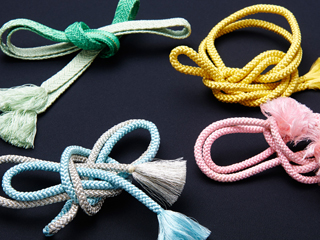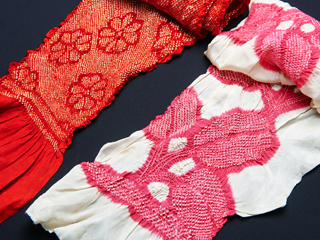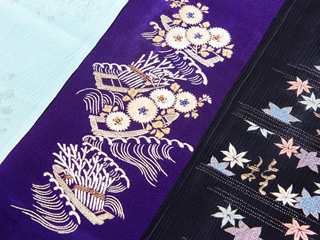Kimono’s Story
The kimono has a long history and the background story of each style and weaving depends upon the locality of origination in Japan. Here, we will introduce some basic knowledge about the kimono and obi (kimono belt). It is like a grandmother opening the old wooden drawer of her dresser, and sharing the unique story of each kimono. Enjoy!
Kimono basics
Coming from one roll of cloth – the ultimate ecological clothing
Do you know that when kimono are taken apart and all the threads are removed, it will turn back into one roll of silk cloth? This is what we call “Tanmono”. Tan is the standard of 12.5 m (approx. 41ft.) length X 38cm (approx. 15 in.) width. When a kimono is made, unused parts of material are not cut out and thrown away, but they are held inside and stitched. So when the threads of any kimono are taken out, it returns to the original shape of one roll of cloth – tanmono. This is a big difference from western dresses. Because of this feature, in old times when kimono were washed, they were unstitched so that it returned them to one roll of cloth. They washed the roll of cloth, put a seaweed based starch on it, and stretched it on a delicate frame made of bamboo bars with needles on top. After this process, the kimono cloth was clean and unwrinkled, just like a new roll of cloth. This process is called “Araihari” (washed, straightened, dried).
The tanmono had many lives. It could be restitched as a larger kimono for a growing young lady. It could be altered to a child’s kimono. By cutting the long sleeves, it could be converted to a semi-formal or daily kimono. Lastly, it could be used to cover cushions for the living room.
Kimono silk is a luxurious resource which maintains its quality even after many transformations. Kimono silk has always been on the cutting-edge of the “slow”, “ecological “ lifestyle. It is the perfect material for upcycling. Goods made of this fine, ancient, fabric can be appreciated and used with love for a long time.
Inheriting spirits and culture
Very high quality kimono which are well preserved can last 50-100 years. A great grandmother who passed her kimono to the grandmother, who passed it to the mother, who passed it to the daughter is not uncommon. In other parts of the world, people inherit jewelry. The kimono is an inherited art, culture, family history and good memories.
Varieties of Kimono
You might be curious about the many kinds of kimono and the different ways of using them. Furisode with its gorgeous, long sleeves is worn by single, young women. Hikizuri with its trailing skirt is worn by geisha, maiko or stage performers of traditional dance. Tomesode is worn by married women and often contains 3 to 5 crests. Houmongi is a semi-formal kimono or “visiting wear”. Komon is a casual kimono and it often has a repeated pattern. Shiromuki is an all white wedding kimono. Yukata is a lightweight summer kimono made of cotton.
World Influence and Internationality
There are many authentic Japanese patterns in kimonos, and yet at the same time there are many influences from other countries. Patterns from China, India and the Middle East came through the Silk Road. Fine silk thread came from China. It is very romantic to think of the many hands involved in the art of kimono from the old days. Kimono culture has grown taking in the essence and arts of the world. Kimono is very elegant, yet international and attracts many people across many borders because of the beauty, the spirit of people involved, and the craftsmanship that comes together and is integrated into one cloth in Japan.
Kimono evening bags will suit all ladies with beautiful hearts, accepting differences of values in diverse cultures. Each bag represents internationality and reflects a global art to a modern world.
Would you like to know more about Kimono?
We can explore the knowledge of Kimono by opening drawers of my grandmother!







